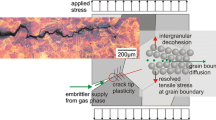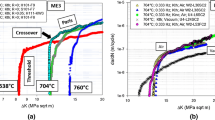Conclusions
-
1.
By using vacuum metallography it was shown that, in Ni−Cr base heat-resistant alloys, grain boundary microcracks substantially normal to the tensile stress appeared after 30–50% of the expected life of the specimen under creep conditions. Their number and size increased with time and eventually led to complete rupture.
-
2.
Failure during creep proceeded in two stages: first stage, gradual development of cracks along grain boundaries; second, short-time fracture. The loss of strength with time was associated with grain boundary crack formation.
-
3.
Intragranular slip was not observed by vacuum metallography during high-temperature testing. This was at least true of magnifications under 200 dias. Rupture occurred by growth of grain boundary cracks. This is why Ni−Cr alloys showing a 10–15% elongation in short-time rupture tests failed most brittlely under creep conditions at the same temperature, with only 1–3% elongation.
-
4.
In tests of relatively short duration, the total elongation at fracture was considerably higher due to extensive intragranular slip.
-
5.
In cast ZhS3 alloy, grain boundary cracks appeared at later creep stages than after preceding working since their development in the cast alloy was hampered by carbide precipitates.
-
6.
Removal of the surface layer by electropolishing considerably increased the pre-crack formation period thereby lengthening the useful life of the material.
Similar content being viewed by others
References
D. Hanson and M. A. Wheeler, Journal Inst. of Metals vol. 45, 1931, #1.
S. N. Zhurkov and B. N. Narzullaev, Zhurn. Tekhn. Fiz., vol. 23, 1953, #10.
S. T. Kishkin, Dokl, Akad. Nauk SSSR, vol. 95, 1954, #4, 789–791.
Ya. B. Fridman and B. A. Drozdovskii, Dokl. Akad. Nauk SSSR, vol. 95, 1954, #4, 793–6. [Available as HB Translation #3504]
I. A. Oding and V. S. Ivanova, Dokl. Akad. nauk SSSR, vol. 103, 1955, #1, 77–80.
S. N. Zhurkov and T. P. Sapfirova, Dokl. Akad. Nauk SSSR, vol. 101, 1955 #2, 237–240.
Ya. S. Umanskii and others. Physics of Metals (Fizicheskoe Metallov.) [Book]. Metallurgizdat, 1955.
S. N. Zhurkov and E. E. Tomashevskii, Zhurn, Tekhn. Fiz., vol. 27, 1957, #6.
M. G. Lozinskii, High Temperature Metal Science (Vysokotemperat. Metallografiya) [Book] Mashgiz Press, 1958, [English Translation by Pergamon Press, T. N.]
Rights and permissions
About this article
Cite this article
Kishkin, S.T., Polyak, É.V. Creep-rupture kinetics of heat-resistant alloys. Met Sci Heat Treat 2, 469–472 (1960). https://doi.org/10.1007/BF00649721
Issue Date:
DOI: https://doi.org/10.1007/BF00649721




